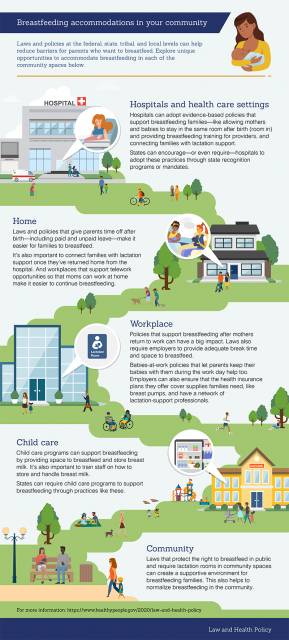You are here
New Report Examines How Law and Policy Can Increase Breastfeeding Rates, Leading to Better Health Outcomes For Mothers And Babies
Law and policy can help increase breastfeeding rates and duration and improve health outcomes for mothers and babies according to a new report from the Healthy People 2020 Law and Health Policy Project. The report presents evidenced-based policy solutions that can be used across the country by communities, local governments, maternal and public health practitioners and other interested stakeholders.
The Law and Health Policy Project is a collaboration among the Centers for Disease Control and Prevention (CDC), the CDC Foundation, the Robert Wood Johnson Foundation and the U.S. Department of Health and Human Services (HHS).
Breastfeeding provides several health benefits for mothers and babies, including reduced risks for asthma and diabetes in babies and lower risk for high blood pressure and certain cancers for mothers. Breastfeeding supports an infant’s immune system and provides nutrients which foster growth and development. For mothers, breastfeeding mobilizes key nutrients accumulated during pregnancy and helps to reset maternal physiology. All major U.S. medical organizations recommend six months of exclusive breastfeeding, followed by continued breastfeeding along with complementary foods throughout the first year of a child’s life. One target of the national Healthy People 2020 initiative is to increase the proportion of infants who are breastfed.
More than 4 out of 5 women breastfeed their babies immediately following birth, but many mothers face barriers that prevent them from continuing to breastfeed despite the health benefits. The report outlines these barriers can be both structural and environmental.
While health providers are generally knowledgeable about the health benefits to mothers and babies from continued breastfeeding, many say they don't have adequate training to help families who may experience difficulty. There are effective training programs that have been developed to help providers by organizations like the Centers for Disease Control and Prevention (CDC) and the American Academy of Pediatrics (AAP).
One example of a successful training program is the Baby Friendly Hospital Initiative (BFHI) established by the World Health Organization (WHO) and the United Nations Children's Fund (UNICEF). The BFHI developed Ten Steps Care, which are 10 specific steps outlined to improve breastfeeding outcomes. Research has shown that mothers who give birth in Ten Steps hospitals are more likely to continue breastfeeding beyond their child's first birthday. These steps are now endorsed by many maternal and child health authorities. The impact of these initiatives can be furthered by providing mothers with important equipment such as breast pumps. The Affordable Care Act requires most insurance companies to cover breastfeeding support and supplies at no cost.
In addition to education and access, the report finds that family leave policies play an important role in a mother's ability to continue breastfeeding. As of December 2019, only 9 states and the District of Columbia will guarantee paid family leave by 2022, according to the latest data. Mothers with longer maternity leave time are more likely to keep breastfeeding after they return to their workplace. In California, which passed a paid leave law in 2004, breastfeeding rates increased up to 20% statewide. The report outlines that once mothers return to work they also need support from their employers. This includes flexible work schedules and designated private, hygienic spaces for mothers to pump and store breastmilk.
State and local health departments also serve as a critical resource for families. These departments are provided with federal funding to support breastfeeding initiatives to help new mothers. Initiatives associated with increased breastfeeding rates include Temporary Assistance for Needy Families (TANF) and The Special Supplemental Nutrition Program for Women, Infants, and Children (WIC). These programs help mothers receive job training and financial assistance while also providing them with education on exclusively breastfeeding their babies and help to address challenges low-income families may face. Some programs visit families in their homes to help them with breastfeeding challenges like the Health Resources and Services Administration's (HRSA) Maternal, Infant, and Early Childhood Home Visiting program (MIECHV).
While there are many evidence-based approaches to encourage breastfeeding, gaps in research make it difficult to evaluate the efficacy of specific laws or policies. The report authors call for additional research and recommend national, state and local stakeholders leverage existing laws and policies to support breastfeeding goals. These steps will create communities and environments that effectively promote and support breastfeeding, an outcome that will lead to better health nationwide.
For more information about this report, the U.S. Breastfeeding Committee (USBC) will host a webinar with the report authors on May 20th. For more information and to register, please visit their website.

